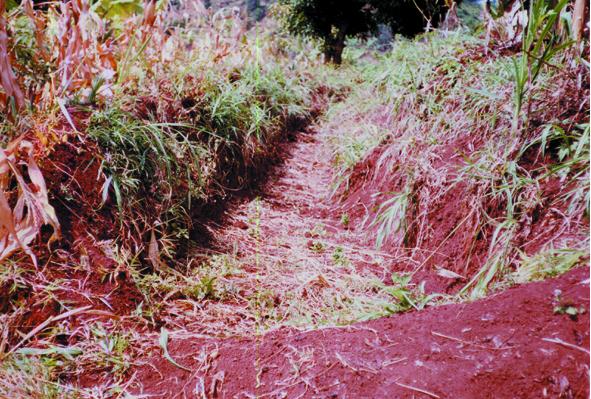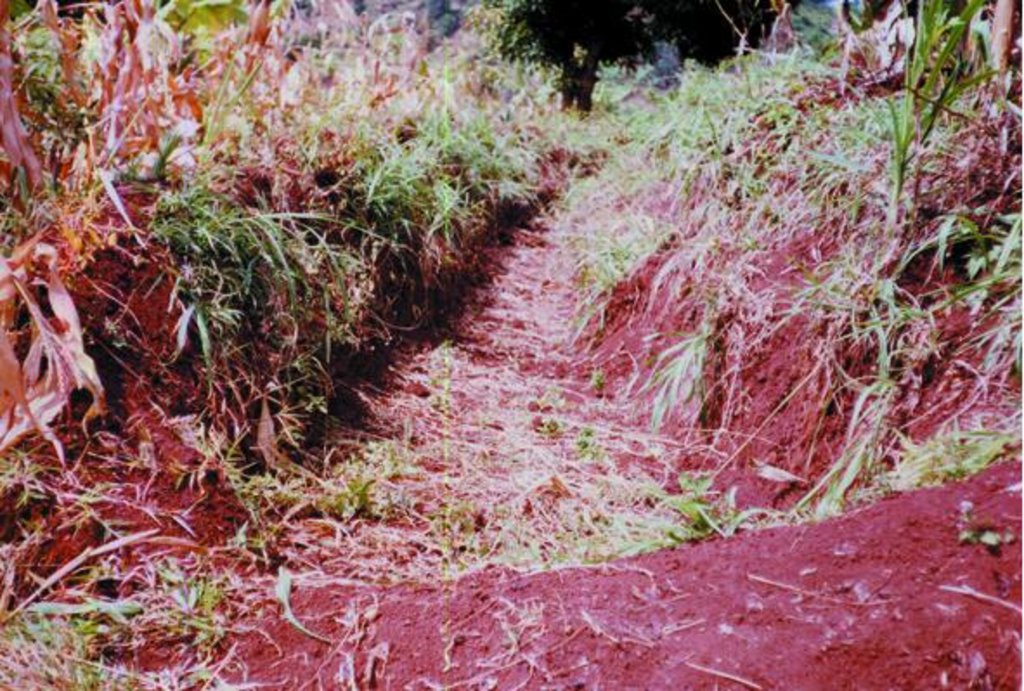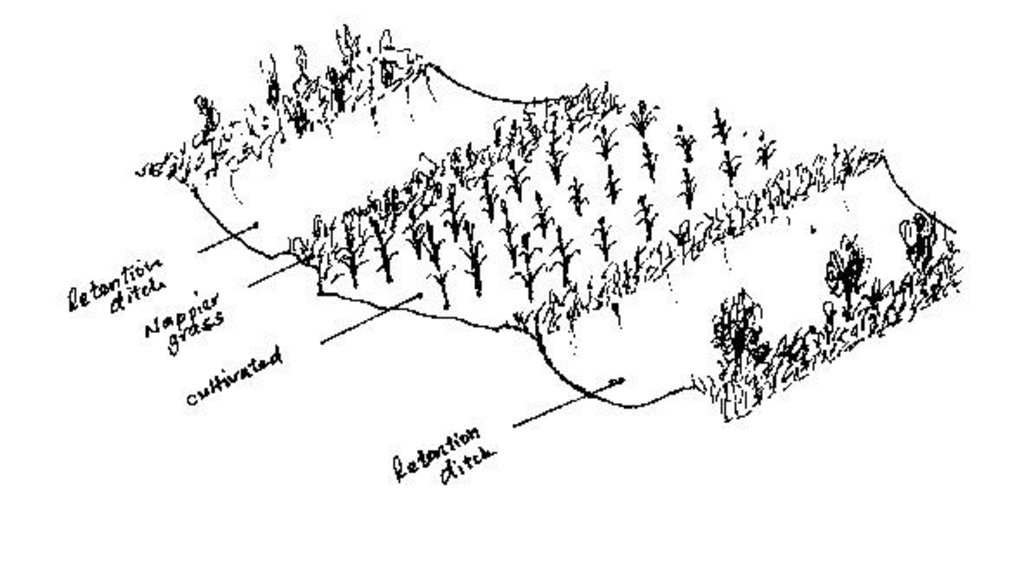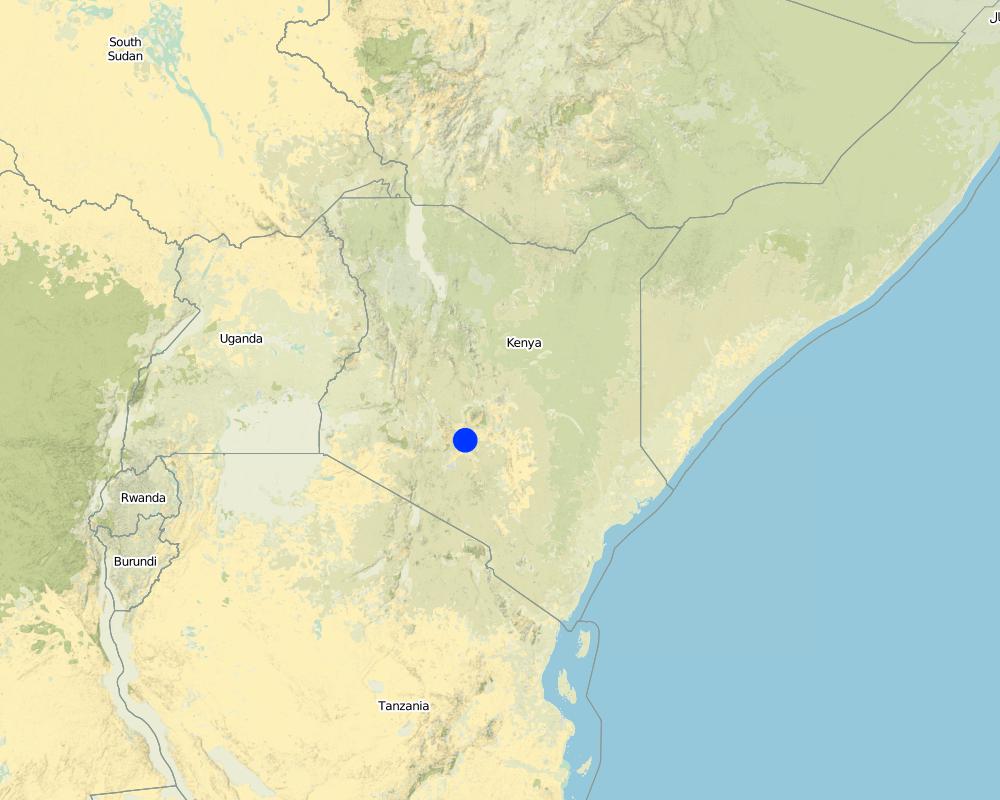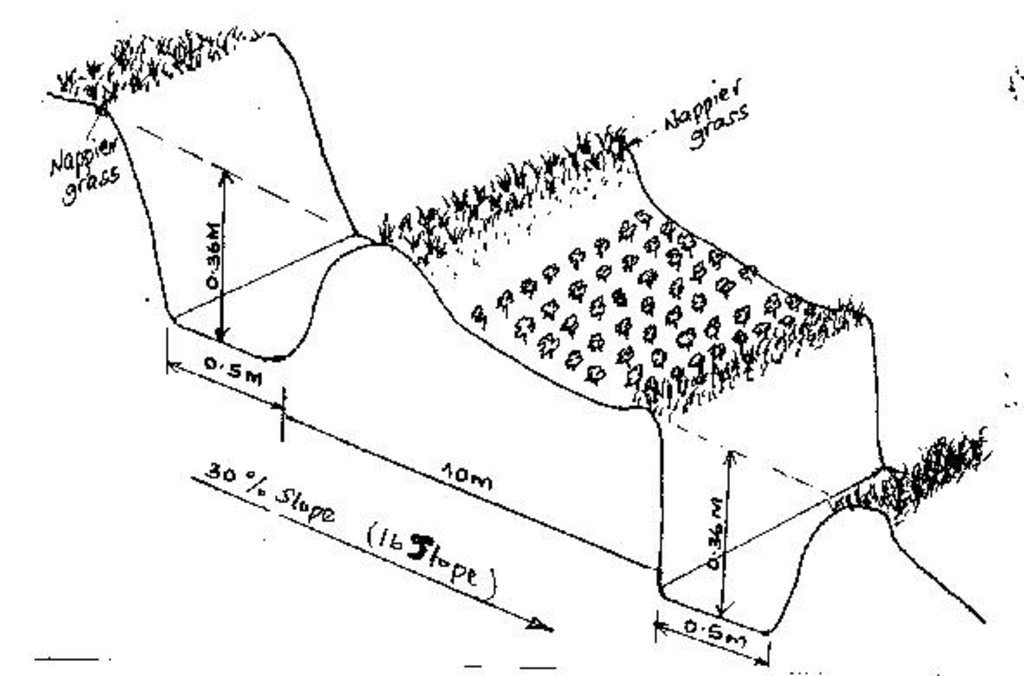Retention ditch Murang'a [肯尼亚]
- 创建:
- 更新:
- 编制者: Unknown User
- 编辑者: –
- 审查者: David Streiff, Alexandra Gavilano
Nyakinyua
technologies_1485 - 肯尼亚
查看章节
全部展开 全部收起1. 一般信息
1.2 参与该技术评估和文件编制的资源人员和机构的联系方式
有助于对技术进行记录/评估的机构名称(如相关)
Ministry of Agriculture, Livestock and Fisheries (MoA) - 肯尼亚1.3 关于使用通过WOCAT记录的数据的条件
编制者和关键资源人员接受有关使用通过WOCAT记录数据的条件。:
是
2. SLM技术的说明
2.1 技术简介
技术定义:
A ditch across the slope for trapping /retaining runoff to encourage infiltration
2.2 技术的详细说明
说明:
Constructed at zero gradient with closed ends, wide and deep to hold all expected runoff. The purpose is prevent the concentrated runoff from reaching the cultivated land. It is manually constructed and maintenance is seasonal.It is used where soils are deep , stable and well drained. These structures are unsuitable in areas susceptible to land slides . They are also not very suitable in areas with very deep soils that are not stable.
2.3 技术照片
2.5 已应用该技术的、本评估所涵盖的国家/地区/地点
国家:
肯尼亚
区域/州/省:
Central
具体说明该技术的分布:
- 均匀地分布在一个区域
如果技术均匀分布在一个区域,则指定覆盖的区域(单位为平方千米):
2.5
如果不知道精确的区域,请注明大致覆盖的区域:
- 1-10 平方千米
注释:
Total area covered by the SLM Technology is 2.5 km2.
The area is agroecological zone UM3 and occupied by about 320 farmers
Map
×2.6 实施日期
如果不知道确切的年份,请说明大概的日期:
- 不到10年前(最近)
2.7 技术介绍
详细说明该技术是如何引入的:
- 通过项目/外部干预
注释(项目类型等):
Introduced by Ministry of agriculture extension staff through the elapesd national soil and water conservation programme.
3. SLM技术的分类
3.1 该技术的主要目的
- 减少、预防、恢复土地退化
3.2 应用该技术的当前土地利用类型

农田
- 一年一作
- 乔木与灌木的种植
年作 - 具体指明作物:
- 饲料作物 - 草
具体说明:
Longest growing period in days: 120 Longest growing period from month to month: Mar - Jul Second longest growing period in days: 90 Second longest growing period from month to month: Oct - Dec
注释:
Main crop: Nappier grass
Major land use problems (compiler’s opinion): Soil erosion and loss of soil fertility
Major land use problems (land users’ perception): Soil erosion, high cost of farm inputs, poor infrastructure.
Type of cropping system and major crops comments: maize, potatoes and beans planted at the beginning of the rainy season.
3.4 供水
该技术所应用土地的供水:
- 雨养
3.5 该技术所属的SLM组
- 引水和排水
3.6 包含该技术的可持续土地管理措施

结构措施
- S4:平沟、坑
3.7 该技术强调的主要土地退化类型

土壤水蚀
- Wt:表土流失/地表侵蚀
- Wg:冲沟侵蚀/沟蚀

水质恶化
- Ha:干旱化
注释:
Main type of degradation addressed: Wt: loss of topsoil / surface erosion
Secondary types of degradation addressed: Wg: gully erosion / gullying, Ha: aridification
3.8 防止、减少或恢复土地退化
具体数量名该技术与土地退化有关的目标:
- 减少土地退化
4. 技术规范、实施活动、投入和成本
4.1 该技术的技术图纸
技术规范(与技术图纸相关):
Technical knowledge required for field staff / advisors: moderate
Technical knowledge required for land users: low
Main technical functions: control of concentrated runoff: retain / trap, increase of infiltration, water harvesting / increase water supply
Construction material (earth): placed on the lower side of the ditch
Lateral gradient along the structure: 0%
Vegetation is used for stabilisation of structures.
4.2 有关投入和成本计算的一般信息
其它/国家货币(具体说明):
Kenya shilling
如相关,注明美元与当地货币的汇率(例如1美元=79.9巴西雷亚尔):1美元=:
78.0
注明雇用劳工的每日平均工资成本:
1.50
4.3 技术建立活动
| 活动 | 时间(季度) | |
|---|---|---|
| 1. | excavation | dry spell |
| 2. | planting of grass on the embarkment | on set of rains |
| 3. | None | None |
| 4. | None | None |
4.4 技术建立所需要的费用和投入
注释:
Duration of establishment phase: 12 month(s)
4.5 维护/经常性活动
| 活动 | 时间/频率 | |
|---|---|---|
| 1. | desilting channel | dry spell/twice per year |
| 2. | gapping the napier grass | wet season/twice per year |
4.6 维护/经常性活动所需要的费用和投入(每年)
注释:
length of 1 m structure (retention ditch).
4.7 影响成本的最重要因素
描述影响成本的最决定性因素:
labour availability, depth/width of ditch. The cost of labour
5. 自然和人文环境
5.1 气候
年降雨量
- < 250毫米
- 251-500毫米
- 501-750毫米
- 751-1,000毫米
- 1,001-1,500毫米
- 1,501-2,000毫米
- 2,001-3,000毫米
- 3,001-4,000毫米
- > 4,000毫米
农业气候带
- 潮湿的
- 半湿润
5.2 地形
平均坡度:
- 水平(0-2%)
- 缓降(3-5%)
- 平缓(6-10%)
- 滚坡(11-15%)
- 崎岖(16-30%)
- 陡峭(31-60%)
- 非常陡峭(>60%)
地形:
- 高原/平原
- 山脊
- 山坡
- 山地斜坡
- 麓坡
- 谷底
垂直分布带:
- 0-100 m a.s.l.
- 101-500 m a.s.l.
- 501-1,000 m a.s.l.
- 1,001-1,500 m a.s.l.
- 1,501-2,000 m a.s.l.
- 2,001-2,500 m a.s.l.
- 2,501-3,000 m a.s.l.
- 3,001-4,000 m a.s.l.
- > 4,000 m a.s.l.
关于地形的注释和进一步规范:
Slopes on average: Also moderate
5.3 土壤
平均土层深度:
- 非常浅(0-20厘米)
- 浅(21-50厘米)
- 中等深度(51-80厘米)
- 深(81-120厘米)
- 非常深(> 120厘米)
土壤质地(表土):
- 粗粒/轻(砂质)
- 中粒(壤土、粉土)
表土有机质:
- 中(1-3%)
- 低(<1%)
如有可能,附上完整的土壤描述或具体说明可用的信息,例如土壤类型、土壤酸碱度、阳离子交换能力、氮、盐度等。:
Soil fertility is low - medium
Soil drainage / infiltration is medium - good
Soil water storage capacity is medium - high
5.6 应用该技术的土地使用者的特征
非农收入:
- 低于全部收入的10%
相对财富水平:
- 贫瘠
- 平均水平
机械化水平:
- 手工作业
说明土地使用者的其他有关特征:
Population density: 200-500 persons/km2
Annual population growth: < 0.5%
2% of the land users are rich and own 5% of the land.
80% of the land users are average wealthy and own 70% of the land.
18% of the land users are poor and own 25% of the land.
Off-farm income specification: employment in urban centres. The income is used to suppliment the cost of establishment and maintenance of the SWC structure.
5.8 土地所有权、土地使用权和水使用权
土地所有权:
- 个人,未命名
- 个人,有命名
土地使用权:
- 个人
6. 影响和结论性说明
6.1 该技术的现场影响
生态影响
水循环/径流
地表径流
SLM之前的数量:
30
SLM之后的数量:
0
土壤
土壤流失
SLM之前的数量:
150
SLM之后的数量:
15
6.4 成本效益分析
技术收益与技术建立成本相比如何(从土地使用者的角度看)?
短期回报:
稍微积极
长期回报:
非常积极
技术收益与技术维护成本/经常性成本相比如何(从土地使用者的角度看)?
短期回报:
轻度消极
长期回报:
中性/平衡
6.5 技术采用
- 1-10%
如若可行,进行量化(住户数量和/或覆盖面积):
387 households in an area of 2.5 sq km
在所有采用这项技术的人当中,有多少人是自发的,即未获得任何物质奖励/付款?:
- 91-100%
注释:
Comments on acceptance with external material support: estimates
100% of land user families have adopted the Technology without any external material support
Comments on spontaneous adoption: estimates
There is a moderate trend towards spontaneous adoption of the Technology
Comments on adoption trend: more people are adopting the technology
7. 参考和链接
7.1 信息的方法/来源
7.2 参考可用出版物
标题、作者、年份、ISBN:
Murang'a district dev Plan. 2002.
可以从哪里获得?成本如何?
RPD, Ministry of Finance.
标题、作者、年份、ISBN:
SWC manual for Kenya. 1997.
可以从哪里获得?成本如何?
MoA/SWCB Nairobi
标题、作者、年份、ISBN:
farm management handbook. 1983.
可以从哪里获得?成本如何?
MoA/FMD Nairobi
链接和模块
全部展开 全部收起链接
无链接
模块
无模块


